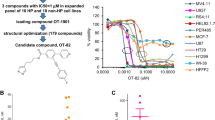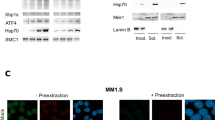Abstract
Parthenolide is selectively toxic to leukemia cells; however, it also activates cell protective responses that may limit its clinical application. Therefore, we sought to identify agents that synergistically enhance parthenolide’s cytotoxicity. Using a high-throughput combination drug screen, we identified the anti-hyperglycemic, vildagliptin, which synergized with parthenolide to induce death of the leukemia stem cell line, TEX (combination index (CI)=0.36 and 0.16, at effective concentration (EC) 50 and 80, respectively; where CI <1 denotes statistical synergy). The combination of parthenolide and vildagliptin reduced the viability and clonogenic growth of cells from acute myeloid leukemia patients and had limited effects on the viability of normal human peripheral blood stem cells. The basis for synergy was independent of vildagliptin’s primary action as an inhibitor of dipeptidyl peptidase (DPP) IV. Rather, using chemical and genetic approaches we demonstrated that the synergy was due to inhibition of the related enzymes DPP8 and DPP9. In summary, these results highlight DPP8 and DPP9 inhibition as a novel chemosensitizing strategy in leukemia cells. Moreover, these results suggest that the combination of vildagliptin and parthenolide could be useful for the treatment of leukemia.
This is a preview of subscription content, access via your institution
Access options
Subscribe to this journal
Receive 12 print issues and online access
$259.00 per year
only $21.58 per issue
Buy this article
- Purchase on Springer Link
- Instant access to full article PDF
Prices may be subject to local taxes which are calculated during checkout





Similar content being viewed by others
References
Lowenberg B, Downing JR, Burnett A . Acute myeloid leukemia. N Engl J Med 1999; 341: 1051–1062.
Burnett A, Wetzler M, Lowenberg B . Therapeutic advances in acute myeloid leukemia. J Clin Oncol 2011; 29: 487–494.
Shipley JL, Butera JN . Acute myelogenous leukemia. Exp Hematol 2009; 37: 649–658.
Guzman ML, Rossi RM, Karnischky L, Li X, Peterson DR, Howard DS et al. The sesquiterpene lactone parthenolide induces apoptosis of human acute myelogenous leukemia stem and progenitor cells. Blood 2005; 105: 4163–4169.
Guzman ML, Rossi RM, Neelakantan S, Li X, Corbett CA, Hassane DC et al. An orally bioavailable parthenolide analog selectively eradicates acute myelogenous leukemia stem and progenitor cells. Blood 2007; 110: 4427–4435.
Zunino SJ, Ducore JM, Storms DH . Parthenolide induces significant apoptosis and production of reactive oxygen species in high-risk pre-B leukemia cells. Cancer Lett 2007; 254: 119–127.
Carlisi D, D'Anneo A, Angileri L, Lauricella M, Emanuele S, Santulli A et al. Parthenolide sensitizes hepatocellular carcinoma cells to TRAIL by inducing the expression of death receptors through inhibition of STAT3 activation. J Cell Physiol 2011; 226: 1632–1641.
Gopal YN, Chanchorn E, Van Dyke MW . Parthenolide promotes the ubiquitination of MDM2 and activates p53 cellular functions. Mol Cancer Ther 2009; 8: 552–562.
Hassane DC, Sen S, Minhajuddin M, Rossi RM, Corbett CA, Balys M et al. Chemical genomic screening reveals synergism between parthenolide and inhibitors of the PI-3 kinase and mTOR pathways. Blood 2010; 116: 5983–5990.
Skrtic M, Sriskanthadevan S, Jhas B, Gebbia M, Wang X, Wang Z et al. Inhibition of mitochondrial translation as a therapeutic strategy for human acute myeloid leukemia. Cancer cell 2011; 20: 674–688.
Spagnuolo PA, Hu J, Hurren R, Wang X, Gronda M, Sukhai MA et al. The antihelmintic flubendazole inhibits microtubule function through a mechanism distinct from Vinca alkaloids and displays preclinical activity in leukemia and myeloma. Blood 2010; 115: 4824–4833.
Chou TC, Talalay P . Quantitative analysis of dose-effect relationships: the combined effects of multiple drugs or enzyme inhibitors. Adv Enzyme Regul 1984; 22: 27–55.
Chou TC . Preclinical versus clinical drug combination studies. Leuk Lymphoma 2008; 49: 2059–2080.
Eberhard Y, Gronda M, Hurren R, Datti A, MacLean N, Ketela T et al. Inhibition of SREBP1 sensitizes cells to death ligands. Oncotarget 2011; 2: 186–196.
Sato K, Aytac U, Yamochi T, Yamochi T, Ohnuma K, McKee KS et al. CD26/dipeptidyl peptidase IV enhances expression of topoisomerase II alpha and sensitivity to apoptosis induced by topoisomerase II inhibitors. Br J Cancer 2003; 89: 1366–1374.
Xu GW, Ali M, Wood TE, Wong D, Maclean N, Wang X et al. The ubiquitin-activating enzyme E1 as a therapeutic target for the treatment of leukemia and multiple myeloma. Blood 2010; 115: 2251–2259.
Kirby M, Yu DM, O'Connor S, Gorrell MD . Inhibitor selectivity in the clinical application of dipeptidyl peptidase-4 inhibition. Clin Sci 2010; 118: 31–41.
Sauve M, Ban K, Momen MA, Zhou YQ, Henkelman RM, Husain M et al. Genetic deletion or pharmacological inhibition of dipeptidyl peptidase-4 improves cardiovascular outcomes after myocardial infarction in mice. Diabetes 2010; 59: 1063–1073.
Yao TW, Kim WS, Yu DM, Sharbeen G, McCaughan GW, Choi KY et al. A novel role of dipeptidyl peptidase 9 in epidermal growth factor signaling. Mol Cancer Res 2011; 9: 948–959.
Burkey BF, Hoffmann PK, Hassiepen U, Trappe J, Juedes M, Foley JE . Adverse effects of dipeptidyl peptidases 8 and 9 inhibition in rodents revisited. Diabetes Obes Metab 2008; 10: 1057–1061.
Eppert K, Takenaka K, Lechman ER, Waldron L, Nilsson B, van Galen P et al. Stem cell gene expression programs influence clinical outcome in human leukemia. Nat Med 2011; 17: 1086–1093.
Gentles AJ, Plevritis SK, Majeti R, Alizadeh AA . Association of a leukemic stem cell gene expression signature with clinical outcomes in acute myeloid leukemia. JAMA 2010; 304: 2706–2715.
Kikushige Y, Shima T, Takayanagi S, Urata S, Miyamoto T, Iwasaki H et al. TIM-3 is a promising target to selectively kill acute myeloid leukemia stem cells. Cell Stem cell 2010; 7: 708–717.
Majeti R, Becker MW, Tian Q, Lee TL, Yan X, Liu R et al. Dysregulated gene expression networks in human acute myelogenous leukemia stem cells. Proc Natl Acad Sci USA 2009; 106: 3396–3401.
He H, Tran P, Yin H, Smith H, Batard Y, Wang L et al. Absorption, metabolism, and excretion of [14C]vildagliptin, a novel dipeptidyl peptidase 4 inhibitor, in humans. Drug Metab Dispos 2009; 37: 536–544.
Hu P, Yin Q, Deckert F, Jiang J, Liu D, Kjems L et al. Pharmacokinetics and pharmacodynamics of vildagliptin in healthy Chinese volunteers. J Clin Pharmacol 2009; 49: 39–49.
Rosenstock J, Niggli M, Maldonado-Lutomirsky M . Long-term 2-year safety and efficacy of vildagliptin compared with rosiglitazone in drug-naive patients with type 2 diabetes mellitus. Diabetes Obes Metab 2009; 11: 571–578.
Rummey C, Metz G . Homology models of dipeptidyl peptidases 8 and 9 with a focus on loop predictions near the active site. Proteins 2007; 66: 160–171.
Yu DM, Ajami K, Gall MG, Park J, Lee CS, Evans KA et al. The in vivo expression of dipeptidyl peptidases 8 and 9. J Histochem Cytochem 2009; 57: 1025–1040.
Maes MB, Dubois V, Brandt I, Lambeir AM, Van der Veken P, Augustyns K et al. Dipeptidyl peptidase 8/9-like activity in human leukocytes. J Leukoc Biol 2007; 81: 1252–1257.
Abbott CA, Yu DM, Woollatt E, Sutherland GR, McCaughan GW, Gorrell MD . Cloning, expression and chromosomal localization of a novel human dipeptidyl peptidase (DPP) IV homolog, DPP8. Eur J Biochem 2000; 267: 6140–6150.
Moro PJ, Quilici J, Giorgi R, Cuisset T, By Y, Boussuges A et al. Mononuclear cell adenosine deaminase and CD26/dipeptidylpeptidase-IV activities are sensitive markers of reperfusion during percutaneous transluminal angioplasty. Int J Cardiol 2011; e-pub ahead of print 5 November 2011; PMID: 22062893.
Tan EY, Richard CL, Zhang H, Hoskin DW, Blay J . Adenosine downregulates DPPIV on HT-29 colon cancer cells by stimulating protein tyrosine phosphatase(s) and reducing ERK1/2 activity via a novel pathway. Am J Physiol Cell Physiol 2006; 291: C433–C444.
Yu DM, Wang XM, McCaughan GW, Gorrell MD . Extraenzymatic functions of the dipeptidyl peptidase IV-related proteins DP8 and DP9 in cell adhesion, migration and apoptosis. FEBS J 2006; 273: 2447–2460.
Sulda ML, Abbott CA, Macardle PJ, Hall RK, Kuss BJ . Expression and prognostic assessment of dipeptidyl peptidase IV and related enzymes in B-cell chronic lymphocytic leukemia. Cancer Biol Ther 2010; 10: 180–189.
de Andrade CF, Bigni R, Pombo-de-Oliveira MS, Alves G, Pereira DA . CD26/DPPIV cell membrane expression and DPPIV activity in plasma of patients with acute leukemia. J Enzyme Inhib Med Chem 2009; 24: 708–714.
Romano MF, Lamberti A, Bisogni R, Tassone P, Pagnini D, Storti G et al. Enhancement of cytosine arabinoside-induced apoptosis in human myeloblastic leukemia cells by NF-kappa B/Rel- specific decoy oligodeoxynucleotides. Gene Ther 2000; 7: 1234–1237.
Wang W, Adachi M, Kawamura R, Sakamoto H, Hayashi T, Ishida T et al. Parthenolide-induced apoptosis in multiple myeloma cells involves reactive oxygen species generation and cell sensitivity depends on catalase activity. Apoptosis 2006; 11: 2225–2235.
Yip-Schneider MT, Nakshatri H, Sweeney CJ, Marshall MS, Wiebke EA, Schmidt CM . Parthenolide and sulindac cooperate to mediate growth suppression and inhibit the nuclear factor-kappa B pathway in pancreatic carcinoma cells. Mol Cancer Ther 2005; 4: 587–594.
Zhang S, Lin ZN, Yang CF, Shi X, Ong CN, Shen HM . Suppressed NF-kappaB and sustained JNK activation contribute to the sensitization effect of parthenolide to TNF-alpha-induced apoptosis in human cancer cells. Carcinogenesis 2004; 25: 2191–2199.
Acknowledgements
We thank Dr John Dick (University Health Network, Toronto, ON) for the use of TEX cells. This study was supported by research grants to ADS by the Leukemia/Lymphoma Society and PAS by The University of Waterloo. PAS was supported by the Canadian Institutes for Health Research postdoctoral fellowship and the Lady Tata Memorial Trust Award.
Author information
Authors and Affiliations
Corresponding author
Ethics declarations
Competing interests
The authors declare no conflict of interest.
Additional information
Supplementary Information accompanies the paper on the Leukemia website
Supplementary information
Rights and permissions
About this article
Cite this article
Spagnuolo, P., Hurren, R., Gronda, M. et al. Inhibition of intracellular dipeptidyl peptidases 8 and 9 enhances parthenolide’s anti-leukemic activity. Leukemia 27, 1236–1244 (2013). https://doi.org/10.1038/leu.2013.9
Received:
Revised:
Accepted:
Published:
Issue Date:
DOI: https://doi.org/10.1038/leu.2013.9
Keywords
This article is cited by
-
In vitro cytogenetic assessment and comparison of vildagliptin and sitagliptin
Cytotechnology (2019)
-
DPP8/DPP9 inhibitor-induced pyroptosis for treatment of acute myeloid leukemia
Nature Medicine (2018)
-
Vildagliptin and its metabolite M20.7 induce the expression of S100A8 and S100A9 in human hepatoma HepG2 and leukemia HL-60 cells
Scientific Reports (2016)
-
The Dipeptidyl Peptidases 4, 8, and 9 in Mouse Monocytes and Macrophages: DPP8/9 Inhibition Attenuates M1 Macrophage Activation in Mice
Inflammation (2016)
-
Inhibition of dipeptidyl peptidase 8/9 impairs preadipocyte differentiation
Scientific Reports (2015)



